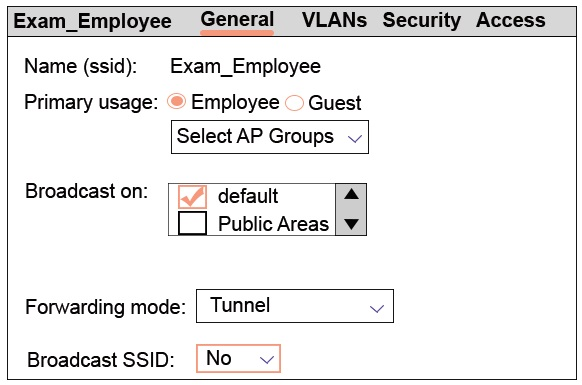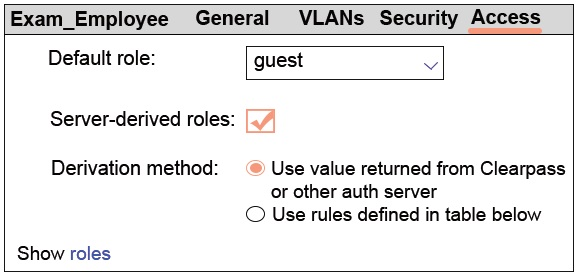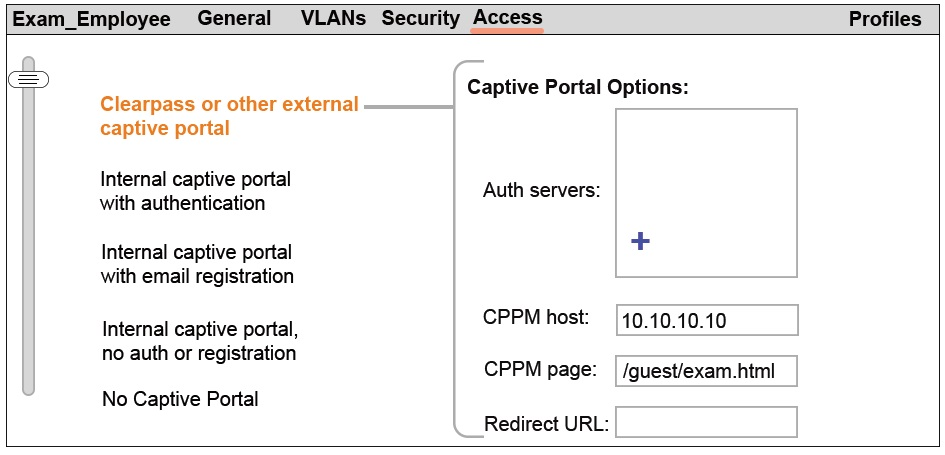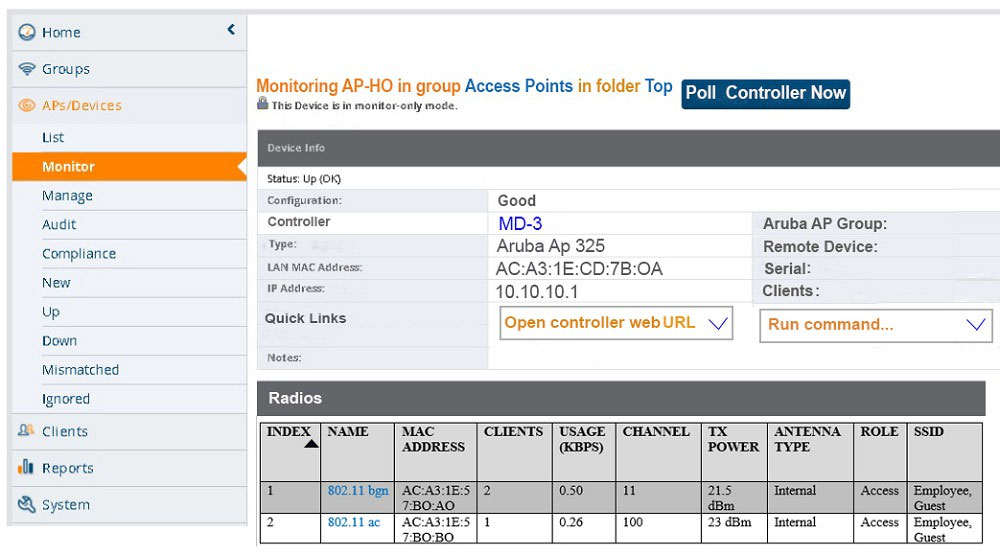Implementing Aruba WLAN (IAW) 8 v1.0
Question 1
A company deploys a wireless network in a typical office environment with many surfaces where the signal can bounce. Which 802.11 technology uses the characteristics of this environment to increase wireless speeds?
- A. Channel bonding
- B. Multiple Input Multiple Output (MIMO)
- C. Transmit Power Control (TPC)
- D. QAM modulation
Answer : B
Question 2
Refer to the exhibit.

What describes the behavior for this WLAN?
- A. APs in the default group broadcast the SSID. Clients can connect to the WLAN on APs in the default group only.
- B. No APs broadcast the SSID. Clients cannot connect to the WLAN until administrators activate it.
- C. No APs broadcast the SSID. Clients can connect to the WLAN on APs in the default gorup only.
- D. APs in the default group broadcast the SSID. Clients can connect to the WLAN on APs in any group.
Answer : C
Question 3
Assume that administrators accept the default forwarding mode for WLANs. How does wireless user traffic flow in a master-local architecture, and how does it flow in a Mobility Master (MM) architecture?
- A. In the master-local architecture, all traffic is tunneled to the master controller to handle. In a MM architecture, all traffic is tunneled to the MM to handle.
- B. In both architectures, APs forward corporate user traffic locally and tunnel guest user traffic to a Mobility Controller (MC) to handle.
- C. In both architectures, traffic is tunneled to a Mobility Controller (MC) to handle.
- D. In the master-local architecture, traffic is tunneled to a local Mobility Controller (MC) to handle. In a MM architecture, all traffic is tunneled to the MM to handle.
Answer : B
Question 4
Refer to the exhibit.

A network administrator sets up the Exam_Employees WLAN on an Aruba solution with a default role of guest, as shown in the exhibit. To which users does the guest role apply?
- A. users who successfully authenticate and are assigned to the default role by the RADIUS server
- B. users who successfully authenticate and are not assigned a different role by the RADIUS server
- C. users who have connected to the SSID, but have not yet attempted authentication
- D. users who fail authentication
Answer : B
Question 5
Which settings can a Mobility Master (MM) deploy to Mobility Controllers (MCs) but master controllers CANNOT deploy to local controllers?
- A. radio profiles
- B. AAA profiles
- C. VLAN settings
- D. WLAN settings
Answer : A
Question 6
A company has an Aruba Mobility Master (MM)-based solution. Where can network administrators look to monitor the health status of all controllers, APs, and clients?
- A. the top banner
- B. the MM Maintenance pages
- C. the Performance dashboard
- D. the Potential Issues dashboard
Answer : A
Question 7
A network administrator creates an employee WLAN on an Aruba solution that uses WLAN WPA2-Enterprise security and an external RADIUS server. When the administrator tests the WLAN, the test client receives limited connectivity and cannot access any resources, but the RADIUS server shows that the user authenticated successfully.
What should the administrator check as a possible source of this issue?
- A. the connectivity between the AP that the client is associated to and the MC
- B. the firewall role and policy that apply to this user
- C. the certificate on the RADIUS server
- D. the connectivity between the Master Controller (MC) for the client and the RADIUS server
Answer : B
Question 8
How does a high-gain omni-directional antenna compare to a typical omni-directional antenna?
- A. it provides more multi-user spatial streams.
- B. it provides more coverage in the horizontal direction than in the vertical direction.
- C. it provides more single-user spatial streams.
- D. it provides more coverage in both the horizontal and vertical directions.
Answer : B
Question 9
A company has an Aruba solution and wants to provide guests with wireless access. The company wants to assign guests IP addresses in subnets that exist only within the Aruba solution.
Which feature should network administrators set up so guests can send traffic on the Internet without changes to the company routing solution?
- A. Enable NAT on the VLAN assigned to the guest WLAN.
- B. Set up a dynamic default gateway on the Mobility Controllers (MCs).
- C. Create destination NAT rules for the guest role.
- D. Enable policy-based routing for the guest traffic.
Answer : A
Question 10
A company plans to deploy a Mobility Master (MM). The MM will manage 50 Mobility Controller (MC) appliances that will control a total of 700 APs, and 10 Virtual
Mobility Controllers (VMCs) that will control a total of 200 APs.
How many MM licenses does the company require?
- A. 60
- B. 210
- C. 900
- D. 960
Answer : D
Explanation:
Starting with ArubaOS 8.0.1, the MM license is required to terminate devices (controllers or APs) on Mobility Master. If the Mobility Master does not have sufficient
MM licenses and an AP fails to obtain a license, that AP can get an IP address and connect to its controller, but will not broadcast an SSID.
Question 11
Which class of controller is more appropriate in a branch installation with up to 64 APs?
- A. 7008
- B. 7030
- C. 7205
- D. 7210
Answer : B
Question 12
A company has an Aruba Mobility Master (MM)-based solution that runs ArubaOS 8 and uses the default AirMatch and Client Match settings. The ARM profile has been disabled for 5GHz radios. How are channel and transmit power settings managed for these radios?
- A. with legacy ARM
- B. with Rule Based Client Match
- C. with legacy Client Match
- D. with AirMatch
Answer : D
Question 13
Refer to the exhibit.

A network administrator creates a guest WLAN on an Aruba Mobility Master (MM). The exhibit shows some of the settings for the WLAN.
How should the network administrator handle the Auth server settings?
- A. Add an authentication server with the LDAP type and the IP address of the company AD server.
- B. Add an authentication server with the LDAP type and IP address 10.10.10.10.
- C. Add an authentication server with the RADIUS type and IP address 10.10.10.10.
- D. Add an authentication server with the RADIUS type and the IP address of the company AD server.
Answer : C
Question 14
Refer to the exhibit.

A network administrator needs to use Aruba AirWave to view statistics for an AP"™s 802.11ac radio. How can the administrator update the information on-demand rather than wait the typical interval?
- A. Click Poll Controller Now
- B. Click the 802.11ac link
- C. Log out of the interface and log back in
- D. Refresh the browser
Answer : A
Question 15
A company has an Aruba solution. The company wants to support a guest WLAN with the internal captive portal, but the company also wants to develop their own custom portal pages.
What correctly describes the level of customization that the internal captive portal supports?
- A. The internal captive portal must use the default pages without modification, but administrators can upload pages developed externally.
- B. Administrators can modify the default internal captive portal pages, but cannot upload pages developped externally.
- C. Administrators can modify the default internal captive portal pages or upload pages developped externally.
- D. The internal captive portal must use the default pages without modification, and administrators cannot upload pages developped externally.
Answer : C